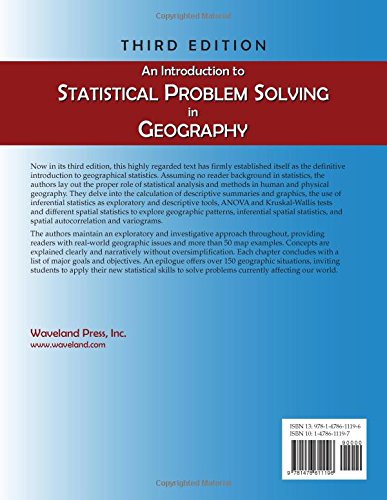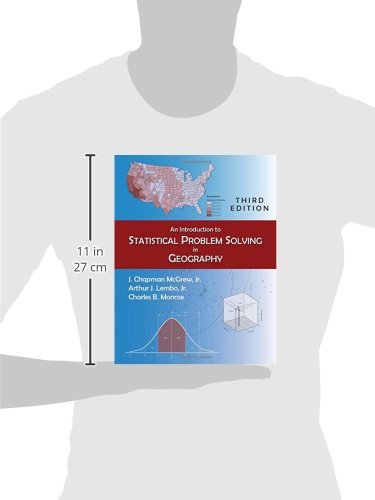



Full description not available
T**R
An Introduction to Statistical Problem Solving in Geography, Third Edition
A fantastic book. Explains concepts well and opens new avenues in all GIS operations.A must have book for everyone to have very close to their workstations.
L**W
Are there other options? Not really.
This book is useful for a quick reference. I don’t always remember all the tests and their various parameters. There are definitely typos.
A**R
Very detailed and helpful
Started with the original version 20+ years ago, and took a class from one of the Authors (McGrew) in Maryland.Regularly reference the book as I work with geographic and statistical data on a daily basis. It is not a "light" read, however, it is one of the most useful books I have. Just received the updated book.
N**X
Good in parts
This is the 2014 third edition of a text first published by J. ChapmanMcGrew and Charles B. Monroe with Wm. C. Brown in 1993 and by the sameauthors with McGraw-Hill in 2000. Unusually for this kind of text, eachedition has seen major rewriting. McGrew (1946-2014) is, sad to say, nolonger with us, but Arthur J. Lembo provides much new material for thisedition.I count five other texts in English introducing statistical methods togeographers published in the last decade (Rogerson 2020 from SAGE,Dadson 2017 from John Wiley, McCarroll 2017 from CRC Press, Harris andJarvis 2011 from Prentice Hall, Walford 2011 from John Wiley), togetherwith two others that focus more specifically on introducing spatialanalysis (O'Sullivan and Unwin 2010 from John Wiley, Lloyd 2010 fromOxford University Press). Some earlier books remain in print and, quitepossibly, in play for many purposes. Naturally the field is even widerif more advanced books or those primarily aimed at other disciplines areconsidered. Even these introductory texts vary greatly in level andcontent, giving teachers and student and researcher readers alikeconsiderable choice.The biases of this text start with not just a preponderance of examplesfrom the United States, but also a presumption that all readers arebased there, as shown by allusions to "the nation", "the President", andso on. I am British and could cite similarly parochial and embarrassingfocus in books published in Britain, so the advice must be to lookelsewhere if that irritates you or is not what you want. Similarly, mostof the examples and even most of the content come from human geography,despite a genuine attempt to broaden the scope. (What I think is themost interesting example of all, a dataset on dates of late spring frostin the South-Eastern United States, is climatological.)The authors include very strong cartographical emphasis, which manygeographers will welcome. Choropleth (patch) maps are even the mostcommon single display for data in the book, beating out histograms andscatter plots. Clearly, but also crucially, interpreting those mapscorrectly depends on knowing which areas are which, and indeed muchabout them. The 50 US states are always assumed to be identifiable tothe reader of several maps without name or abbreviation cues. Other wayround, the coverage of modern graphical methods is weak, with nothing onsay dot or strip charts or scatter plot matrices, and very little use ofquantile or regression diagnostics plots. One section on multipleregression has no graphs whatsoever, an unfortunate low.The authors reasonably insist on the value of seeing statisticalapplications as aimed at solving geographical problems. Their mostdistinctive feature is providing detailed discussions for most majorexamples. But I suspect that these will work differently for differentpeople, being valuable context and motivation for some and long-windedpadding for others. The extra detail strikes me as more than a littleabsurd when it is invented for several examples using fictitious data(Middletown in Clinton County, and so forth).As a statistics book, this one works hard at explaining the logic andeven the detailed calculations behind many methods without assumingmathematics at more than moderate high school level (so, no calculus, nomatrix algebra). Unfortunately, it is far from free of gaffes, garble,and gaps. My comments below range from identification of outright errorsand muddle to suggestions based on personal taste and judgment. Whatfollows are examples of problems, not an exhaustive list.Notation. The authors are seemingly well aware of the importance ofdefining notation and making important distinctions thereby. In practicenotation is often a mess, being variously unnecessary, inconsistent,non-standard, poorly chosen, or just wrong.Skewness and kurtosis. Once past the standard fare of mean, median,standard deviation, quartiles and so forth, a hard test of authors ishow they handle distribution shape. Here as often the account ofskewness and kurtosis is peppered with small and large errors. Forexample, the diagram on p.52 supposedly shows distributions withdiffering kurtosis, but the contrast is between distributions withsimilar level and shape but differing spread.Neglect of transformations. Analysing -- even just plotting -- data onsome transformed scale is a standard method which belongs in everyintroductory text. Most commonly, that means using a logarithmic scale.I was very surprised by the neglect of this device until it was declaredbeyond the scope of the book on p.262. Logarithms do, however, appear inthe discussion of Poisson distributions.Confidence and significance procedures. Unlike various competing texts,this one is lucid on the fundamental difference between parameters beingestimated and statistics being used to estimate them. There is alsohelpful stress on the role of P-values (observed significance levels) asthe key result of significance tests. Unfortunately their definition onp.147 as the exact probability of getting a test statistic of a givenmagnitude if the null hypothesis is true omits the key extra details "ora magnitude more extreme" and "with a sample of this size". Then onp.148 a riff on P-values as objects of belief, conviction, faith, andtrust goes way beyond their correct interpretation. Later there are manystatements such as "We can be virtually 100% confident that the simplelinear regression model is statistically significant", which at bestsays the same thing twice. What is missed, and to be fair statisticiansthemselves do not always explain this well, is that "significance" and"confidence" are just terms of art, referring to particularprobabilities, which are objective in the sense that researchersfollowing the same recipe should get the same results, yet fallible inthe sense that they could be very wrong if data do not approximatevarious ideal conditions. Explaining either term as the strength ofconviction the researcher is entitled to feel goes in the wrongdirection.Normal distributions. Unsurprisingly, normal distributions appear fairlyearly but only much later in the book are readers advised on how tocheck for normality. The recommended Kolmogorov-Smirnov test is a verypoor method (and in any case needs adjustment when parameters areestimated from the data, as they usually are). A better and simplermethod is to use normal quantile plots, but readers deserved more andbetter examples than one graph showing a small sample based on fakedata. The central limit theorem is rightly mentioned, but withoutemphasising that it also applies to non-normal parent distributions,which is most of the point. Unfortunately, the authors promote mythsthat the Wilcoxon test, correlation, and regression require normaldistributions. This is true only in a very limited sense if correlationsare used in inference, as even then other procedures are possible(bootstrapping, permutation tests, etc.).Spatial analysis. Clearly, many geographical datasets are spatial, butexplaining and exemplifying relevant methods at this level is a stiffchallenge, demanding more statistical machinery and considerablestatistical maturity. The weakest chapter is on point pattern analysis.It is sometimes salutary to learn that apparent clustering is consistentwith a purely random pattern, but more commonly clustered patterns beingconfirmed as clustered is a quantification of the obvious, servingmainly to raise the much harder problem of analysing the underlyingprocesses. A repeated example of wildfires in New Mexico mentions, butdoes not really grapple with, a fundamental geographical fact:Variations in land cover, including large areas of desert, make anyassumption of homogeneity utterly implausible. The treatment ofautocorrelation is better, but a much briefer section on variograms isconfused on several details.Terminology. The authors sometimes fly free with their own variations onstandard terms. Random is defined to mean equal chances and stochasticto mean unequal chances, which greatly over-extends specific terminologysuch as that of random sampling or complete spatial randomness. Rather,the fundamental contrast is between random processes and deterministicprocesses. Another unhelpful idiosyncrasy is to call residuals "absoluteresiduals", a term which also invites confusion given the mathematicaldefinition of absolute values.So, the book can only be recommended as being good in parts. Teachers ofthis material may find, as I did, examples to fold back into their owncourses. Unfortunately, the careless or diffident reader who skims andskips hoping or expecting only to grasp the gist may find it morerewarding than a conscientious and diligent reader struggling with itsmuddle and misinformation. Geographers wanting to learn statisticalmethods are likely to be better off with a general statistics text orone written for a cognate discipline.
T**Y
Damaged merchandise
The cover and several pages had been cut and taped back together. The cover was not clean.
J**N
Four Stars
Great information that I doubt I will comprehend even in 3 years
Trustpilot
1 week ago
1 month ago